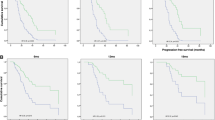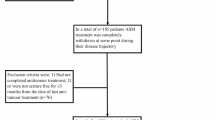Abstract
Introduction
Tumor-related epilepsy may respond to chemotherapy. In a previously-published multi-centre randomized clinical trial of 562 elderly glioblastoma patients, temozolomide plus short-course radiotherapy conferred a survival benefit over radiotherapy alone. Seizure outcomes were not reported.
Methods
We performed an unplanned secondary analysis of this trial’s data. The trial design has been previously reported. Seizures were recorded by clinicians as adverse events and by patients in quality of life questionnaires. A Chi-square test of seizure rates between the two groups (α = 0.05) and a Kaplan–Meier estimator of time-to-first self-reported seizure were planned.
Results
Almost all patients were followed until they died. In the radiotherapy alone group, 68 patients (24%) had a documented or self-reported seizure versus 83 patients (30%) in the temozolomide plus radiotherapy group, Chi-square analysis showed no difference (p = 0.15). Patients receiving radiotherapy alone tended to develop seizures earlier than those receiving temozolomide plus radiotherapy (p = 0.054). Patients with seizures had shorter overall survival than those without seizures (hazard ratio 1.24, p = 0.02).
Conclusions
This study was not powered to detect differences in seizure outcomes, but temozolomide seemed to have minimal impact on seizure control in elderly patients with glioblastoma.
Clinical Trial Registration: NCT00482677 2007-06-05.


Similar content being viewed by others
Data availability
The datasets used and analyzed for the current study are available from the corresponding author on reasonable request.
References
Koekkoek JAF, Dirven L, Heimans JJ et al (2015) Seizure reduction in a low-grade glioma: more than a beneficial side effect of temozolomide. J Neurol Neurosurg Psychiatry 86:366–373. https://doi.org/10.1136/jnnp-2014-308136
Haggiagi A, Avila EK (2019) Seizure response to temozolomide chemotherapy in patients with WHO grade II oligodendroglioma: a single-institution descriptive study. Neuro-Oncol Pract 6:203–208. https://doi.org/10.1093/nop/npy029
Sherman JH, Moldovan K, Yeoh HK et al (2011) Impact of temozolomide chemotherapy on seizure frequency in patients with low-grade gliomas. J Neurosurg 114:1617–1621. https://doi.org/10.3171/2010.12.JNS101602
Brada M, Viviers L, Abson C et al (2003) Phase II study of primary temozolomide chemotherapy in patients with WHO grade II gliomas. Ann Oncol 14:1715–1721. https://doi.org/10.1093/annonc/mdg371
Pace A, Vidiri A, Galiè E et al (2003) Temozolomide chemotherapy for progressive low-grade glioma: clinical benefits and radiological response. Ann Oncol 14:1722–1726. https://doi.org/10.1093/annonc/mdg502
Avila EK, Chamberlain M, Schiff D et al (2017) Seizure control as a new metric in assessing efficacy of tumor treatment in low-grade glioma trials. Neuro-Oncol 19:12–21. https://doi.org/10.1093/neuonc/now190
Stupp R, Mason WP, van den Bent MJ et al (2005) Radiotherapy plus concomitant and adjuvant temozolomide for glioblastoma. N Engl J Med 352:987–996. https://doi.org/10.1056/NEJMoa043330
Perry JR, Laperriere N, O’Callaghan CJ et al (2017) Short-course radiation plus temozolomide in elderly patients with glioblastoma. N Engl J Med 376:1027–1037. https://doi.org/10.1056/NEJMoa1611977
Vecht CJ, Kerkhof M, Duran-Pena A (2014) Seizure prognosis in brain tumors: New insights and evidence-based management. Oncologist 19:751–759. https://doi.org/10.1634/theoncologist.2014-0060
Forsgren L, Bucht G, Eriksson S, Bergmark L (1996) Incidence and clinical characterization of unprovoked seizures in adults: A prospective population-based study. Epilepsia 37:224–229. https://doi.org/10.1111/j.1528-1157.1996.tb00017.x
Perucca P, Camfield P, Camfield C (2014) Does gender influence susceptibility and consequences of acquired epilepsies? Neurobiol Dis 72:125–130. https://doi.org/10.1016/j.nbd.2014.05.016
Bruna J, Miró J, Velasco R (2013) Epilepsy in glioblastoma patients: basic mechanisms and current problems in treatment. Expert Rev Clin Pharmacol 6:333–344. https://doi.org/10.1586/ecp.13.12
Greene C, Hanley N, Campbell M (2019) Claudin-5: gatekeeper of neurological function. Fluids Barriers CNS 16:1–15. https://doi.org/10.1186/s12987-019-0123-z
Friedman A (2011) Blood–brain barrier dysfunction, status epilepticus, seizures, and epilepsy: A puzzle of a chicken and egg? Epilepsia 52:19–20. https://doi.org/10.1111/j.1528-1167.2011.03227.x
Chen H, Judkins J, Thomas C et al (2017) Mutant IDH1 and seizures in patients with glioma. Neurology 88:1805–1813. https://doi.org/10.1212/WNL.0000000000003911
Werhahn KJ (2009) Epilepsy in the elderly. Dtsch Arzteblatt Int 106:135–142. https://doi.org/10.3238/arztebl.2009.0135
Werhahn KJ, Trinka E, Dobesberger J et al (2015) A randomized, double-blind comparison of antiepileptic drug treatment in the elderly with new-onset focal epilepsy. Epilepsia 56:450–459. https://doi.org/10.1111/epi.12926
Funding
None.
Author information
Authors and Affiliations
Contributions
All authors interpreted the data and revised the manuscript for intellectual content. S.C., C.O., and W.M. contributed to the study conception and design. Data collection and analysis were performed by A.A.B., G.C., M.F., N.L., J.M., R.N., J.P., C.P., W.R., W.W., and W.M. The statistical analysis was performed by K.D. The first draft of the manuscript was written by S.C. and all authors commented on previous versions of the manuscript. All authors read and approved the final manuscript.
Corresponding author
Ethics declarations
Conflict of interest
The authors declare that we have no conflict of interest.
Ethical approval
This trial was approved by each institutional review board of participating institutions. The procedures used in this study adhere to the tenets of the Declaration of Helsinki.
Consent to participate
Each patient provided written informed consent.
Additional information
Publisher's Note
Springer Nature remains neutral with regard to jurisdictional claims in published maps and institutional affiliations.
Rights and permissions
About this article
Cite this article
Climans, S.A., Brandes, A.A., Cairncross, J.G. et al. Temozolomide and seizure outcomes in a randomized clinical trial of elderly glioblastoma patients. J Neurooncol 149, 65–71 (2020). https://doi.org/10.1007/s11060-020-03573-x
Received:
Accepted:
Published:
Issue Date:
DOI: https://doi.org/10.1007/s11060-020-03573-x




